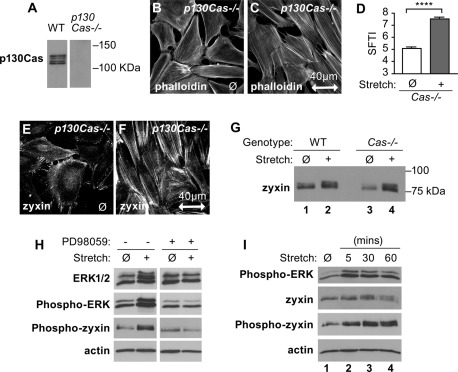FIGURE 3:
Zyxin responds independent of signaling molecule p130Cas. (A) Western immunoblot for p130Cas in WT and Cas-null fibroblasts. (B, C) Fibroblasts from p130Cas−/− mice were stained for F-actin (phalloidin) on unstretched (ø) membranes or after uniaxial cyclic stretch (1 h, 15%, 0.5 Hz). Stretch direction is in the horizontal plane (double-headed arrow; scale, 40 μm). (D) SFTI analysis of the stretch-induced actin thickening in Cas−/− cells, ****p < 0.0001. (E, F) Immunofluorescence microscopy of zyxin in fibroblasts from p130Cas−/− mice on unstretched (ø) and stretched membranes. (G) Immunoblot analysis of zyxin in cell lysates from unstretched (ø) and stretched (+) membranes (WT, lanes 1 and 2; Cas−/−, lanes 3 and 4) showed the stretch-induced zyxin shift seen in WT cells persists in p130Cas−/− cells. (H) Fibroblasts on unstretched (ø) membranes or after uniaxial cyclic stretch (5 min, 15%, 0.5 Hz) with dimethyl sulfoxide control or with ERK activation inhibitor PD98059 (100 μM) were immunoblotted for total ERK1/2 (p44/p42), P-ERK, P-zyxin, and β-actin. (I) WT fibroblasts unstretched (ø) and stretched for 5, 30, and 60 min, electrophoresed, and immunoblotted for P-ERK, total zyxin, P-zyxin, and β-actin indicate maximal ERK phosphorylation at 5 min, followed by zyxin phosphorylation.

